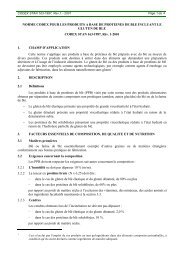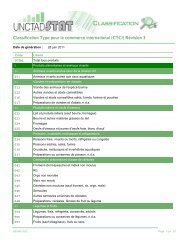issues and constraints related to the development of cashew nuts ...
issues and constraints related to the development of cashew nuts ...
issues and constraints related to the development of cashew nuts ...
You also want an ePaper? Increase the reach of your titles
YUMPU automatically turns print PDFs into web optimized ePapers that Google loves.
20were three buyers each <strong>of</strong>fering successively higher prices. Obviously <strong>the</strong> situation isimproving <strong>the</strong>re.In Sansale region (Guinea), farmers <strong>of</strong>ten exchanged <strong>cashew</strong> for rice; in 1999, one bag <strong>of</strong> ricewas equivalent <strong>to</strong> 1.5 bags <strong>of</strong> <strong>cashew</strong>, while in year 2000 it had increased <strong>to</strong> two bags <strong>of</strong> rice =one bag <strong>of</strong> <strong>cashew</strong>. In Guinea Bissau bartering for rice was a very common practice.The majority <strong>of</strong> farmers did not have a problem selling <strong>the</strong>ir harvest. In <strong>the</strong> more remote or newareas, <strong>the</strong> situation is improving <strong>and</strong> will continue <strong>to</strong> improve, as more farmers plant <strong>cashew</strong>. If<strong>the</strong> lack <strong>of</strong> buyers is a problem, <strong>the</strong>n farmers need <strong>to</strong> co-operate by bulking <strong>the</strong>ir <strong>nuts</strong> <strong>and</strong>arranging transport <strong>the</strong>mselves, where possible.PricesFrom interviews with large numbers <strong>of</strong> farmers, it would appear that generally, <strong>the</strong> maximumprices paid <strong>to</strong> farmers were in-line with what could be expected from international prices.However <strong>the</strong> following problems were apparent:- Prices were variable during <strong>the</strong> season, with disproportionately low prices at <strong>the</strong>beginning <strong>of</strong> <strong>the</strong> season. Farmers who were short <strong>of</strong> cash early in <strong>the</strong> seasonwere forced <strong>to</strong> sell, <strong>of</strong>ten at very low prices- Prices were variable between neighbouring villages at <strong>the</strong> same time <strong>of</strong> year,because buyers were exploiting <strong>the</strong> lack <strong>of</strong> price knowledge <strong>of</strong> farmers- Farmers were lacking information on local <strong>and</strong> international prices- There was no price premium for <strong>nuts</strong> <strong>of</strong> better quality or size. This does notencourage farmers <strong>to</strong> improve <strong>the</strong> quality <strong>of</strong> <strong>the</strong>ir <strong>cashew</strong>, which will become anincreasingly important fac<strong>to</strong>r in <strong>the</strong> future- Farmers in remote areas received lower prices, due <strong>to</strong> higher transportation costs.4. Processing status <strong>and</strong> <strong>constraints</strong>The majority <strong>of</strong> raw <strong>nuts</strong> harvested in all <strong>the</strong> five African <strong>cashew</strong>-producing countries are shipped<strong>to</strong> India for processing <strong>and</strong> <strong>the</strong>n re-exported <strong>to</strong> USA, Europe, Japan, etc. Although this route isperfectly acceptable, as farmers can still derive a good income from growing <strong>cashew</strong>, anypotential value-added from processing is lost <strong>to</strong> <strong>the</strong> country.Major benefits are <strong>to</strong> be gained when <strong>the</strong> processing <strong>of</strong> <strong>the</strong> nut <strong>and</strong> <strong>the</strong> apple can be undertakenlocally, ra<strong>the</strong>r than exporting <strong>the</strong> raw commodity. However, care must be taken <strong>to</strong> ensure that<strong>the</strong> farmers do not end up subsidising inefficient <strong>and</strong> unpr<strong>of</strong>itable processing industries. This canhappen if high taxes are imposed on <strong>the</strong> export <strong>of</strong> raw <strong>nuts</strong>, in order <strong>to</strong> allow local processingindustries <strong>to</strong> compete with India.Fur<strong>the</strong>r are given several examples <strong>of</strong> various processing industries in <strong>the</strong> countries visited. GuineaNo processing <strong>of</strong> kernels takes place. Guinea BissauThere was one large <strong>cashew</strong>-processing fac<strong>to</strong>ry <strong>of</strong> Italian origin (probably manufactured byOltremare), which has never functioned. The reasons for <strong>the</strong> demise <strong>and</strong> what must have been a


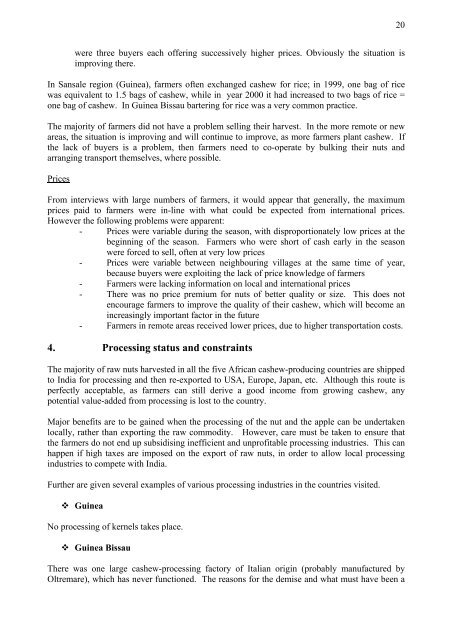
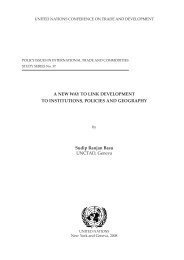


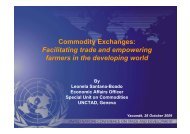
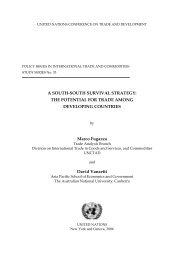

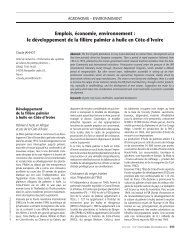
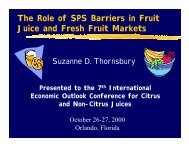

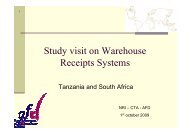
![Warehouse Receipt Systems: Legal Issues [PDF]](https://img.yumpu.com/43979338/1/190x134/warehouse-receipt-systems-legal-issues-pdf.jpg?quality=85)
